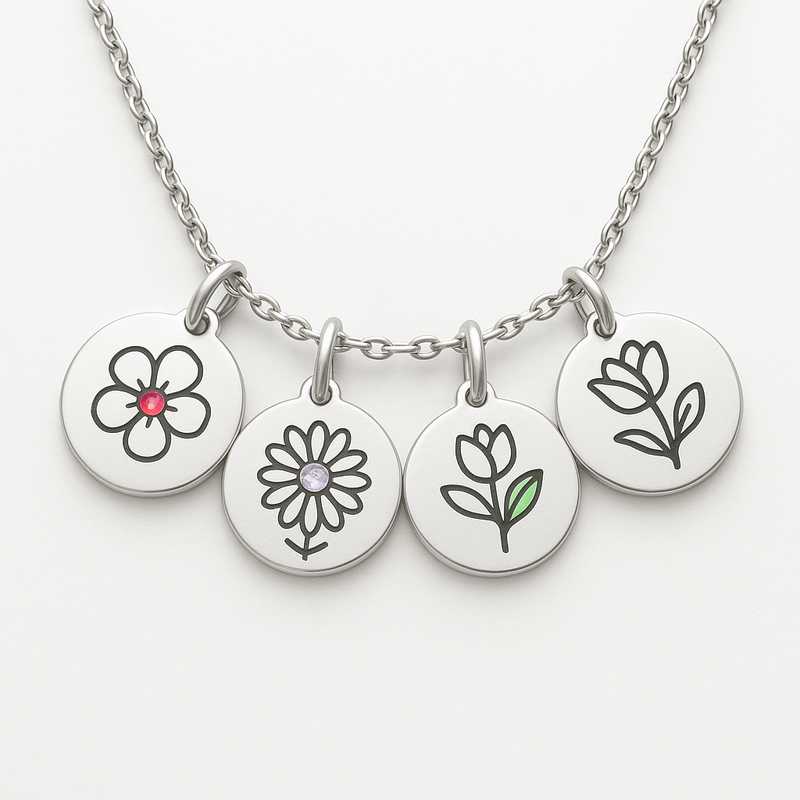Engineered Elegance: The Science Behind Custom Stainless Steel Charms

Introduction: Where Art Meets Engineering
In the competitive world of OEM/ODM stainless steel jewelry manufacturing, customization is no longer a luxury—it’s an expectation. Particularly for birth month flower and birthstone charm necklaces, where sentiment and symbolism demand nothing less than precision, durability, and sustainability. This page dives deep into the material choices and production technologies that empower manufacturers to create elegant stainless steel charms with unparalleled longevity and visual appeal. We highlight the material science behind 304 and 316L stainless steel, innovative manufacturing technologies, and the importance of environmentally friendly processes. The result? Jewelry that isn’t just beautiful, but engineered to last, perform, and leave a lighter footprint on the planet.
Material Integrity: 304 vs. 316L Stainless Steel
When choosing stainless steel for jewelry manufacturing, especially for high-contact wearables like charm necklaces, two grades often take the spotlight: 304 stainless steel and 316L stainless steel. While both are non-magnetic austenitic steels known for their formability and corrosion resistance, there are key differences to consider:
Corrosion Resistance
- 304 Stainless Steel: Contains approximately 18% chromium and 8% nickel. It resists oxidation and rust well under typical indoor conditions but may tarnish or corrode in saline or humid environments over time.
- 316L Stainless Steel: Enhanced with 2-3% molybdenum, it offers superior resistance to chlorides, acids, and saltwater, making it ideal for skin contact, coastal regions, and medical-grade applications.
Application Scenarios
- 304 Use Cases: Cost-efficient designs for everyday wear, seasonal collections, promotional jewelry, and non-coastal market targeting.
- 316L Use Cases: Premium birthstone lines, allergy-friendly options, waterproof designs, and high-wear environments.
Ultimately, 316L stainless steel is the gold standard for high-end jewelry, offering hypoallergenic benefits and lasting brilliance. However, 304 remains a strong contender for budget-conscious projects requiring visual appeal with less exposure to harsh environments.
Precision Engineering: Modern Manufacturing Technologies
In a market driven by intricate design trends and micro-detail personalization, traditional tooling no longer suffices. OEM/ODM jewelry manufacturers are increasingly turning to advanced technologies that deliver both speed and refinement.
Laser Cutting
Laser cutting enables ultra-fine shaping of steel sheets with micron-level accuracy. Ideal for floral outlines or gem settings in charm designs, it eliminates burrs and distortion. This non-contact process reduces waste and tooling costs while enabling mass customization without retooling.
Hydraulic Stamping & Pressing
Hydraulic technology is crucial for shaping birth month flower profiles or raised gemstone beds. Modern CNC-driven hydraulic presses ensure uniform depth, crisp curves, and high repeatability across large production runs. These techniques preserve metal strength and surface consistency.
Corrosion Pattern Etching
Also known as chemical etching or corrosion patterning, this technology creates surface textures and reliefs on charms by selectively dissolving metal. It’s perfect for adding petal veins or gemstone halos. By using acid-resistant resists, manufacturers can create photorealistic textures without mechanical abrasion.
Case Study: Lotus-Inspired Mother’s Day Charm
One standout OEM project involved a lotus flower birthstone charm. Utilizing 316L stainless steel, the manufacturer applied a two-step laser cut followed by hydraulic doming and etching to bring out the subtle contours of petals. The result? A 3D flower charm with high-precision gemstone seats that passed 100-hour salt spray tests without any tarnish or deformation.
Eco-Conscious Craftsmanship: Green Production Protocols
Modern B2B buyers increasingly expect more than aesthetics—they demand environmental accountability. Stainless steel jewelry manufacturers are adopting a variety of green practices to minimize ecological impact without compromising quality.
Closed-Loop Waste Recycling
Scraps from laser cutting and hydraulic pressing are collected and returned to certified steel suppliers for re-smelting. This closed-loop model not only reduces raw material costs but also keeps hundreds of kilograms of stainless waste out of landfills annually.
Green Electroplating Technology
Electroplating enhances the sheen and color of charms but can be environmentally taxing. Green electroplating replaces cyanide- or chrome-based processes with trivalent chromium baths and non-toxic metal salts. Water from plating baths is filtered, pH-balanced, and recycled through reverse osmosis systems, minimizing water waste by over 80%.
Low-Emission Energy Sources
More factories now run on solar-powered grids or hybrid energy setups to reduce carbon output during high-power stages like polishing or sintering. A mid-sized ODM manufacturer recently reported a 28% annual drop in emissions after integrating solar arrays on their facility rooftops.
Certifications and Trust Signals
- ISO 14001: Environmental management standard
- RoHS: Restriction of hazardous substances
- REACH: Registration, Evaluation, and Authorization of Chemicals
Buyers should look for these labels when selecting an OEM/ODM partner to ensure production aligns with global environmental standards.
Design Meets Durability: Real-World OEM Applications
How do these technologies and materials converge in real-world projects? Let’s look at a few examples from leading ODM suppliers:
1. Birth Month Bloom Collection for a European Luxury Brand
This line featured laser-etched daisies, tulips, and roses paired with embedded zirconia birthstones. Manufactured in 316L with low-nickel plating, these pieces were exported to EU markets with full REACH compliance.
2. Modular Charm Necklace Series for Asian Boutique Retailers
Leveraging 304 stainless steel and hydraulic form tooling, the manufacturer offered 12 flower modules with interchangeable magnetic settings for birthstones. Modular design minimized excess inventory and reduced mold costs by 45%.
3. Eco-Jewelry Line for US-Based Wellness Brand
This project prioritized sustainability: laser-precision lotus charms in recycled 316L steel with no plating (raw finish), packaged in biodegradable inserts. This SKU became the brand’s highest reviewed item, praised for both symbolism and ethics.
Conclusion: Partnering for Performance and Purpose
Choosing the right materials and manufacturing techniques is more than a technical decision—it’s a strategic investment in product quality, market positioning, and environmental impact. Whether you seek anti-corrosive strength, intricate floral aesthetics, or a low-emission production model, understanding the full science behind engineered elegance allows B2B clients to make smarter OEM/ODM decisions.
Looking to bring your custom birthstone or flower charm concept to life? Partner with manufacturers who understand how to merge art, technology, and sustainability seamlessly. Reach out today for consultation, technical specs, or a custom quote on your next stainless steel jewelry project.
